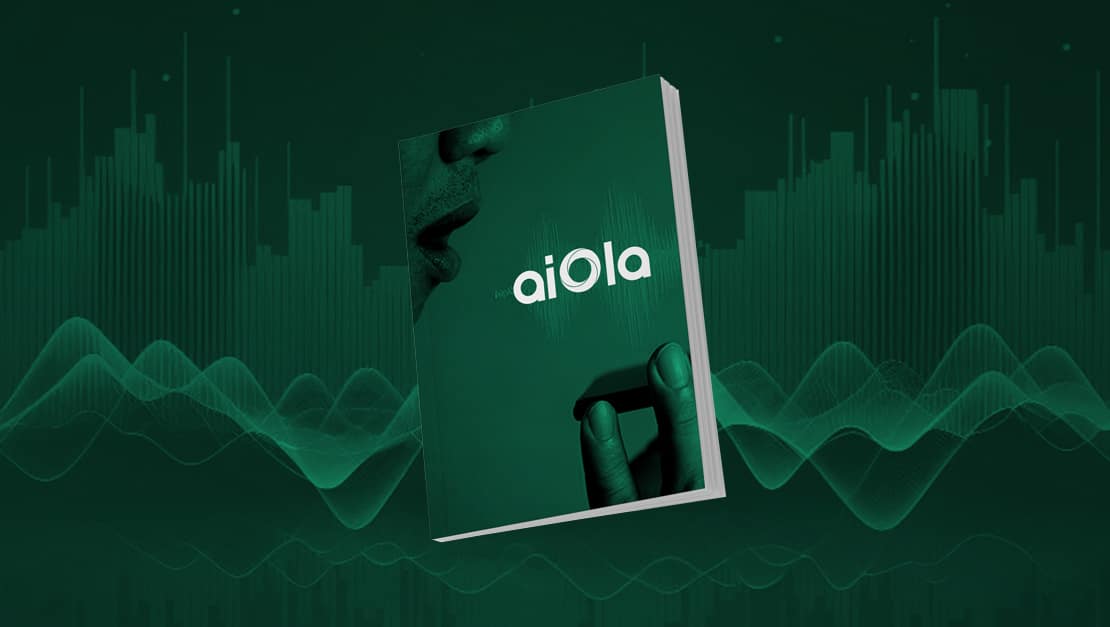What started as basic speech recognition technology has now turned into the sophisticated voice-to-text systems we know today. Artificial intelligence (AI) has propelled these tools to become more versatile and precise.
Speech-to-text software works by listening to audio and creating an output of verbatim text using voice recognition technology. With the infusion of AI, transcriptions can be drastically improved and systems can better understand language nuances thanks to machine learning (ML) and natural language processing (NLP).
In this post, we’ll look at the symbiotic relationship between voice-to-text solutions and AI, examining how the technology works, its benefits, challenges, and examples of platforms on the market today, like aiOla, using it to make an impact in work processes.
How AI for Voice-to-Text Systems Works
The underlying technology of voice-to-text is an amalgamation of different tools and algorithms. A computer program uses complex ML and NLP models to turn audio into text over several steps. A brief breakdown of how this technology works in practice looks like this:
- Audio input: Speech-to-text technology picks up on raw audio input and undergoes processing, often turning vibrations of speech into digital language, to extract relevant features.
- Preprocessing: The audio input then goes through preprocessing with secondary audio, like background noises and irregular frequencies, which are removed to enhance the quality of the sample for better recognition.
- Acoustic models: A voice recognition tool will compare the acoustic and language models to figure out the most likely textual representation based on units of sound. This phase relies on ML and other AI tools to learn the relationship between sound and words.
- Transcription: A voice-to-text platform will then analyze the probabilities of different sounds to find the most likely transcription.
- Post-processing: The initial transcription is refined using AI-based algorithms to consider factors like grammar, syntax, and contextual understanding.
Different AI tools are used at each stage of this process. For example, NLP is important to understand the context of spoken words and analyze the structure of a sentence and the relationship between words, making the ultimate result more accurate and reliable.
Applications of AI Voice-to-Text Technology
AI-powered voice-to-text technology takes on many forms and has many applications and use cases. A report by National Public Radio shows that 57% of voice search users use voice commands daily, demonstrating how reliant we’ve become on voice technology. Overall, the technology can enhance accessibility, efficiency, and the user experience for many existing tools. To better grasp how this technology works in real-world scenarios, let’s look at some applications of voice-to-text technology.
- Virtual assistants like Siri, Alexa, and Google Assistant use an AI voice-to-text generator as the backbone of their systems, enabling voice commands, task completion, and providing information
- Modern transcription services use AI voice-to-text to transcribe spoken words into text, a technology that’s used in legal settings, healthcare, journalism, and education
- Voice-to-text AI tools play an important role in the accessibility of digital content to people with disabilities as they can produce closed captions, use voice commands, or function as screen readers, making technologies more inclusive
- Custom support uses AI voice-to-text tools to analyze incoming calls and direct them more accurately, creating a more personalized customer experience
- Voice commands in vehicles use AI voice-to-text systems to enable hands-free operation of in-car features, making driving safer and more convenient
- Dictation software uses voice-to-text AI technology to convert spoken words into text for hands-free note-taking, which is used for clinical and legal documentation
- Voice-to-text technology is used in emergency services to quickly transcribe distress calls, helping first responders react quickly in situations where immediate action is critical
Advantages of AI-Powered Voice-to-Text
The global speech and voice recognition market value in 2022 was $9.4 billion and is expected to grow to $28.1 billion by 2027. What this shows is that many individual users and businesses have seen the value in voice-to-text technology and are using it to their advantage. Voice-to-text technology comes with many benefits that extend to different use cases and industries. Here are some advantages of the technology:
- Improved accuracy: AI algorithms are continuously learning, improving accuracy in transcriptions and recognizing spoken words
- Multilingual support: With AI, voice-to-text systems can transcribe content in many languages, making it applicable to diverse linguistic needs
- Versatility: The technology can be applied to different applications, like virtual assistance, language learning, customer support, and several other industries
- Increased efficiency: Voice-to-text saves time compared to transcribing text manually, making workflows more efficient in many areas
- Automation: Communication and documentation are streamlined with automated transcription of important notes, calls, or meetings
- Integration: Many voice-to-text systems can integrate with other technologies, like smart devices, helping the entire digital ecosystem advance
Challenges and Limitations of AI Voice-to-Text
Like with any emerging technology, there are always hurdles when it comes to implementation and adoption. While proven to be significantly beneficial to many fields, speech AI tools also bring up some concerns surrounding privacy, biases, and even speech patterns. If your business is considering using an AI voice-to-text app, some of the challenges below will likely arise.
Privacy concerns
Any system that collects and learns spoken language is going to set off some alarms for privacy concerns. When using these apps, your business must have guidelines in place for the safe use, access, and storage of speech and sensitive data.
Handling Various Speech Patterns
Accents, dialects, industry jargon, and other speech patterns can be a challenge for these systems, leading to errors or inaccurate transcriptions. Additionally, users with non-standard speech may find results are often skewed.
AI Biases
Biases in AI models take on different forms if the data it was trained on isn’t diverse enough. AI can reflect societal biases and therefore produce results that can be deemed discriminatory.
Regulatory compliance
You want to ensure your use of voice-to-text technology is compliant with local or global regulations. Data protection regulations, such as GDPR, can be a challenge for voice-to-text applications when it comes to ensuring transparency and user consent.
Leverage the Power of AI Voice-to-Text with aiOla
For businesses looking to make workflows less resource-intensive and more efficient, voice-to-text technology provides a path forward. That said, not all AI voice-to-text online applications or software are relevant for industries like food safety, manufacturing, or fleet management. This is where aiOla fills in the gaps.
aiOla’s AI-powered platform uses speech to complete mission-critical tasks. aiOla enables businesses to cut down on manual tasks like maintenance, inspection, or data collection solely through language and voice. Language gets turned into action that can help reduce time spent on tasks and gather speech-based data that would otherwise be lost. Additionally, aiOla can do this in over 100 languages while detecting any accent, dialect, or industry jargon, producing transcriptions that are highly accurate and reliable.
Voice in Action: aiOla Success Story
To better illustrate how it works, let’s look at a success story of a Fortune 50 American multinational food corporation and how it used aiOla to make food manufacturing workflows more efficient.
The company was conducting inspections manually on machinery, and noting their findings on paper. With this traditional approach, the company found it difficult to keep track of data or accurately analyze it. After implementing aiOla, their inspection time was cut nearly in half thanks to going through checks vocally rather than on paper. Not only that but alerts on machinery malfunctions were sent to the right team members instantly, reducing downtime and speeding up production. Thanks to aiOla, the results speak for themselves:
- 45% decrease in inspection time
- 30% increase in production uptime
- 90% reduction in manual operations
All this was accomplished simply by harnessing the power of voice using aiOla’s AI-driven technology. The Fortune 50 company’s employees were able to focus on more strategic tasks rather than spend time on manual inspections. Since aiOla operates through speech, the employees experienced little to no training, making onboarding a quick and easy affair.
The Transformative Impact of AI Speech-to-Text
AI is changing the way computers and humans speak to each other, and harnessing that power to effect meaningful change in the way we work. From reducing time on manual tasks to making digital tools more accessible and inclusive, AI voice-to-text technology is transforming the way we interact with technology.
Still, finding the best AI voice-to-text system for your unique needs can take time. However, with a platform like aiOla that offers a quick onboarding process and an easy-to-use system, your business can turn speech into action straight away.
Book a demo with one of our experts to learn about how aiOla’s AI-driven voice platform can make your business more efficient.








